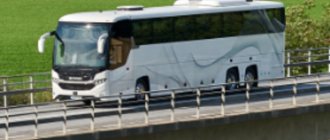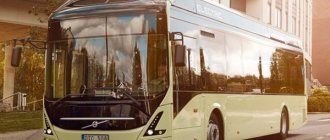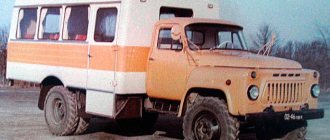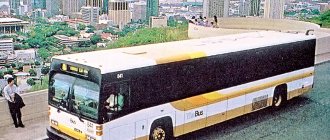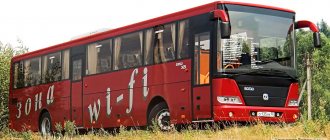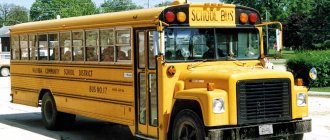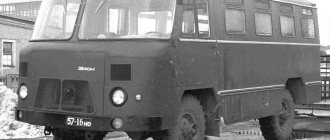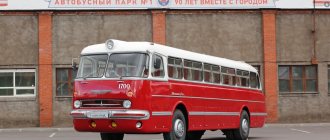October 26, 2017 The Scania IRIZAR I6 bus is a universal, high-quality bus, ideal for intercity and tourist transportation of passengers.
In the line of SCANIA IRIZAR I6 buses, it occupies a special place due to its technical characteristics, design, aerodynamics, elaboration of the smallest details and high level of comfort.
The international reputation of SCANIA and IRIZAR makes the bus a benchmark for safety, reliability and economic profitability.
The SCANIA IRIZAR I6 bus has enormous potential for custom production.
Our customers can choose a package in accordance with their technical and commercial requirements. Traveling on a SCANIA IRIZAR I6 bus is a real pleasure.
Fifth decade - American experience
In the 1950s Scania-Vabis entered with new front-engine bus chassis of the B family, on which third-party bodies were installed. All models were equipped with diesel engines of our own production with a capacity of 90 and 135 hp.
During the same period, Swedish specialists renewed ties with US automakers. This time it was Mack Manufacturing Corp., which, in addition to trucks, also produced buses until 1960. Back in 1949, Scania-Vabis purchased a rear-engined Mack C50 carriage bus for trial operation. After 18 months of testing, it was decided to launch production of this model in Sweden. In return, Scania-Vabis specialists shared their diesel developments with the Americans. The Swedish version was designated C50 Metropol and was equipped with an 8-cylinder naturally-aspirated Scania-Vabis diesel engine producing 180 hp. This was the first bus to be completely assembled in the company's bus workshop in Södertälje. In 1953–1954 200 copies were built, of which 199 were purchased for Stockholm. However, for the Swedish capital, a bus with a length of 12.1 m turned out to be too bulky, so in 1955 it was replaced by the C70 Capitol model, shortened to 10.6 m and lighter, produced until 1959. During this period, 244 buses of three modifications were assembled - 70 /1, 70/2 and 70/3. Based on the C70/3 model, its export version C71 was developed, which was a chassis with a body frame. Four cars were sold to Israel, where they were equipped with body panels at the Haargaz plant.
Finally, in 1959, production of the last bus with American roots began, the C75 Capitol model. Until 1962, 118 vehicles of this type were assembled. On its basis, the export intercity model IC75/2V was created; 12 of these buses were sent to Argentina in 1959. Having adopted overseas experience in building completely complete vehicles with a monocoque body, Scania-Vabis began producing buses with a more traditional design for Sweden.
Due to the expansion of the model range, the designation system for buses began to change: for new models with the power unit located in front of the front axle, the letter F was now added to the indices B (chassis) and C (bus with a monocoque body).
In the first post-war decade, almost half of the 5,507 bus chassis produced were exported. Buses with the Scania-Vabis logo in the 1950s. could be found on the roads of Holland, Belgium, Norway, Finland, Denmark, Spain, Portugal, Greece, India and Syria. Latin American countries occupied a special place in exports. So, in 1956, 600 Scania-Vabis buses were already operating in Argentina. In 1957, in the suburbs of the Brazilian city of Sao Paulo, the Scania-Vabis Motores i São Bernardo assembly plant was opened, which began its activities with the assembly of engines and trucks, and in 1959 it mastered the assembly of front-engine bus chassis of the B75 series. In addition, over 50 body shops worldwide have used Scania-Vabis chassis.
OTHER OPPORTUNITIES
Route signs- Possibility to connect iPod devices
- Digital clock
- Aluminum protective profiles in the luggage compartment floor
- LED lights on the rear bumper
- Partitions in luggage compartments
- Stainless steel construction
- Rear View Camera
- Guide camera
- DVR
- Middle/rear door camera
- Bus washing system
- Fire alarm in toilet
- Fire extinguishing system
- Surveillance cameras
- "Sensitive edge" in luggage compartment hatches
- Parktronic
- Spare mirror in the luggage compartment
- Independent climate systems for driver and passengers
- LED reading lighting
- LED lighting in the aisle
- Shelf in the luggage compartment
- Retractable battery
- Vacuum cleaner
- First aid kit
- Alcolock ignition lock device
Topic: New bus models / Bus test
Sixth decade - change of brand
An important component of the production program continued to be bus chassis types B and BF, which were the successors to the vehicles of previous years. During this period, they were exported to approximately 100 countries around the world, where they were equipped with bodies from various local manufacturers. By the end of the 1960s, sales of front-engine buses in continental Europe had fallen sharply, but they were still in demand in third world countries. Another direction was the production of completely self-made buses of the CF and CR series (as rear-engine vehicles were now designated). But compared to the chassis, their production was limited. Scania-Vabis considered ensuring passenger comfort and environmental protection as its main focus in this area. Thus, in 1966, the production of the CR76 city bus began with a rear-engine layout, characterized by a low floor location and an engine with reduced exhaust levels.
In October 1966, Scania-Vabis acquired the plant of the bodybuilding company Svenska Karosseri Verkstäderna (SKV), located in Katrineholm, where in 1967 it transferred the assembly of CR76 buses from Södertälje, and in 1968 - bus chassis, after which production buses and chassis was allocated to the Scania-Bussar AB division.
On September 3, 1967, the so-called “R-day” came in Sweden, when the transition to right-hand traffic occurred. The decision to travel the same way as in continental Europe was made back in May 1963, and preparations were thoroughly made for the transition. At the beginning of 1967, buses with right-hand drive doors had already begun to be produced “in reserve”, and the production of left-hand drive vehicles was practically curtailed. After the introduction of right-hand traffic, a massive replacement of buses began, for which carriers were given preferential loans and partially subsidized. At the same time, on the still strong buses of previous years, the doors were moved to the other side using a makeshift method, but they were not used for long.
In 1968, the Scania-Vabis brand was renamed Scania. At the same time, in connection with the start of production of the so-called “zero series” trucks, rear-engine BR110M chassis (1968–1973) began to be produced, and buses of the CR76 model were designated CR110M.
In 1969, Scania-Vabis merged with Saab, resulting in the creation of the Saab-Scania AB concern. In the same year, the development of the specific British market began. The BR110M chassis began to be supplied to Foggy Albion, on which the bodybuilding company Metro Cammell Weymann (MCW) mounted the bodies of city buses. The finished product was named Metro-Scania.
LUXURY COMFORT
The updated Irizar i6 model, among its classmates, combines exquisite design and luxury comfort - a comfortable interior, unique design and many options make the bus attractive in the market for both passengers and carriers.
The advantage of the Scania Irizar i6 is that it can be adapted for any type of passenger transportation: from the maximum number of seats and impressive luggage space, to maximum comfort, even driving in a reclining state. The basic level of performance is 3 stars, although there are several options with comfort one star more.
The bus can be built taking into account the individual needs and tastes of the customer, who has a wide selection of interior materials, seat types, and multimedia systems. The salons are equipped with wireless Internet. There is also the ability to connect iPod devices, satellite navigation, monitors built into the seat backs, and an individual audio system.
Interior LED lighting with touch control in the air conditioning panel to turn on the light operates in read mode, call steward, stop signal and seat number illumination.
In some versions, the luxury bus has custom-installed gaming tables, an external awning over the window line, and 220 V power outlets. A separate item includes options for catering on board. For an additional fee, a coffee maker, water cooler, and kitchenette are provided.
Seventh decade - from Britain to Brazil
By the beginning of the 1970s. Scania began to lose its dominant position in the bus market in Scandinavia, so rear-engine bus chassis models BR110M and then BR111M (1974–1978) began to occupy an important place in the production program. However, front-engine chassis were still popular. The most popular of them were the chassis of the BF110 (1968–1975) and BF111 (1975–1981) models, of which 6,971 units were built. The development of city buses continued to pay great attention to the environment. In 1971, production of buses of the CR111M model with a 190-horsepower 6-cylinder diesel engine and automatic transmission began. The bus was distinguished by a reduced noise level (achieved by careful sound insulation of the engine compartment), which did not exceed 77 decibels, which is lower than even modern European standards, which allow a noise level from trucks of 78–80 dBA. Until 1978, 806 buses of this type were assembled. At the same time, production of the BR145 chassis for intercity buses, equipped with a V8 diesel engine with a power of 260 hp, began. The intercity bus model CR145 (1971–1976) was produced on this chassis.
The Brazilian branch played an important role in bus production. Together with him, Scania-Bussar created the BR116 rear-engine chassis for intercity buses, which can be considered one of the most popular Scania brand products of this type. In 1977, chassis production began in Brazil, and a year later in Sweden. A total of 5,624 such chassis were built before 1982. This model was also assembled in Argentina.
In the 1970s Scania continued to expand into the British market. The stagnation of the national automotive industry in Great Britain led to the fact that the famous double-deckers began to be built on Swedish chassis. In 1973–1978 For these purposes, 663 chassis of the BR111DH model were sent to the UK, which were equipped with bodies by MCW, after which the buses received the name Scania Metropolitan. Another British firm was East Lancashire Coachbuilders in 1980–1982. built double-decker buses on the chassis of the BR112DH model.
In 1978, production of the city bus model CR112 began, which became the main vehicle of this type in the production program until 1983, and in 1980, the first articulated chassis BR112A.
In 1980, Scania-Bussar produced 1,800 buses and chassis.
Eighth decade - conquest of America
In the early 1980s. Scania ranks second in the world in the production and export of bus chassis, second only to Daimler-Benz, with up to 90% of its production being exported. For example, during this period the German company G. Auwärter built 1000 Neoplan Jetliner buses on the Scania BR116 chassis. The eighties were notable for frequent and large-scale updates to the model range. In 1981, the production of front-engine chassis of the F and S series began, created on the basis of Scania 2nd generation trucks, but now they were assembled in Brazil, and almost all the products went to Latin American countries to the Camena body plants from Peru, Brazilian Nielson, Busscar , Comil, Siferal, Argentine Cametal. Chassis deliveries also began to Africa (Moroccan Jdidi and CIM, Egyptian El Nasr, Ghabbour, Kenyan Labh Singh), where they were fitted with simplified bodies, colloquially known as “Jungle Buses”.
In 1982, the Scania-Bussar production program was updated and now consisted of the N-series city bus chassis and the K-series intercity bus chassis. They were developed in collaboration with the Brazilian department and unified with the 2nd generation Scania trucks. In 1983, the Scania CR112 bus was renamed and was now produced as the CN112 model. A year later, its articulated modification CN112A appeared. In the same 1984, in the American state of Connecticut, the assembly of buses of the CN112 model for the US market was organized. The chassis and engines for the buses were imported from Sweden, and the bodies and their equipment were assembled from American components. In total, until 1988, about 250 cars of this model were assembled in the USA. In 1988, production of bus chassis and buses unified with 3rd generation trucks began. These included the chassis for city buses of the N113 series, the chassis for city and suburban buses L113 and the chassis for intercity and tourist vehicles of the K113 series. All of them were offered in two- and three-axle versions, and the N series also included the articulated model N113A. This entire model range was produced until 1996, and in Brazil, the K113 series chassis remained on the assembly line until 1998. The only city bus in the production program was the Scania CN113 (1988–1993).
In 1990, 50% of all Scania bus chassis were sold in South America, Europe excluding Scandinavian countries accounted for 23%, and only 8% of vehicles produced remained in Sweden.
Ninth decade – period of unification
In the early 1990s. The production program of bus chassis did not undergo significant changes, but this period became for municipal Russian passenger carriers the time of acquaintance with Swedish buses, which were then imported from Karelian Kostomuksha.
In 1992, Scania began cooperation with the Spanish coachbuilder Irizar. The jointly produced buses were based on the K113 series chassis and were sold through the Scania sales network worldwide. A significant new product was the city bus model CN113CLL MaxCi, which appeared in 1993. It differed from its predecessor in its redesigned body and low entry level. In 1994–1999 this model was assembled at the Scania-Kapena SA joint venture in Slupsk, Poland.
In the first half of the 1990s. the Scania-Bussar AB division was renamed Scania Buses & Coaches, and in 1994 the Saab-Scania concern split into two independent companies - Saab and Scania.
Meanwhile, in 1993, the Dmitrov Scientific and Technical Center “Poisk” began individual production of RusScan-5263 buses on the Scania R113 chassis with bodies unified with the LiAZ-5256. A little later, the delivery of the chassis for the Volzhanin began. In 1995, the assembly of buses on the Scania L113CLB and Scania L94UB chassis with Hess and Duple Metsec bodies began at the Estonian enterprise Baltscan (at the facilities of the Tartu Automobile Repair Plant).
In September 1996, the production of buses and bus chassis of a new generation, created on a modular principle, began in Sweden. At the same time, the unification between bus chassis and 4th generation trucks reached 85%. The range of products included the following rear-engine bus chassis: N series with a transverse engine, K series with a longitudinal engine and L series with a longitudinal and inclined power unit. The assembly of CN94UB OmniCity city buses began on the N series chassis. Their distinctive feature was the ability to tilt the body, making it easier for passengers to access the bus interior at stops. The K series chassis served as the basis for intercity and tourist buses.
In August 1997, the assembly of city buses began at the Scania plant built in 1992 in the French city of Angers. In 1998, the production of city and suburban buses CL94UB OmniLink began, created on the L series chassis. This model also existed in three-axle and articulated versions. In the same year, assembly of the 4th generation chassis began in Brazil. At the same time, the Brazilian production program, unlike the European one, included both front-engine chassis of the F94 series and some “exotic” models, for example, the four-axle chassis K124EB 8x2 420. In 2000, the assembly of OmniLine intercity buses based on the chassis of the series began in Europe K.
Additional options
The possibilities for customizing the aircraft can be expanded by covering the floor with wood, installing a rear view camera and a guide camera, using a DVR and a camera for the middle (rear) door.
Buyers have access to a fire alarm in the toilet, interior surveillance cameras, a “sensitive edge” in the luggage compartment hatches, and parking sensors.
Even the spare tire can be moved from the front to the luggage compartment.
For convenience, you can order a retractable battery, partitions in the luggage compartment and an Alcolock ignition interlock device.
In short, the Scania Irizar i6 is not only created with the latest technology, but also with the latest comfort. And this is what is valued first and foremost on tourist ships.
SOUNDABILITY AND DEVELOPMENT
Back in 1991, Scania, in collaboration with the Spanish coachbuilder Irizar, created an excellent tourist bus that has a comfortable and safe body with. Their design turned out to be so successful, reliable and comfortable that the company’s developers did not stop there. Why is the Scania Irizar i6 bus the choice of many operators throughout Europe? The Scania Irizar i6 coach boasts superb style, long operating life, excellent handling and fuel efficiency. And to keep your business moving forward, Scania is always ready to provide top-notch service.
SPECIAL ATTENTION TO SAFETY
The safety of all passengers is the Scania Irizar i6's top priority. For this reason, Scania invests a significant portion of its profits in the area of safety. It partners with the most reputable design and engineering firms to create and implement the most advanced security and safety technologies.
UNMATCHED RELIABILITY
The design of Irizar i6 buses was developed taking into account the highest requirements for reliability, which guarantees the durability and reliability of our buses for all operators.
It should be noted that Scania Irizar uses components and materials based on the latest developments. The production of Scania Irizar i6 buses takes place mainly using automated but at the same time personalized processes. All of them undergo the most stringent tests at Scania's test site in Sweden. Our buses always show excellent performance.
SERVICE IS A COMPETITIVE ADVANTAGE OF SCANIA IRIZAR – 24 HOURS A DAY, 365 DAYS A YEAR
Service is an important mission of Scania: we work hard to earn and strengthen the trust of our customers.
Scania takes a personal approach to service. It manifests itself from the very first stage of working with the client, when the client chooses a bus and the required equipment in accordance with his needs. From this moment on, our clients are supported by a team of specialists who accompany the vehicle throughout its entire life cycle. Scania stands for high-quality service, providing comprehensive repairs, adjustments and maintenance. In addition, these are modern logistics centers that accept orders for replacement of components and delivery of all necessary parts anywhere in the world in the shortest possible time.
YOUR ECONOMIC BENEFIT!
Scania Irizar i6 buses enable operators to maximize profits by keeping fuel consumption to a minimum and allowing easy maintenance. We have achieved this thanks to the special design of our buses, which ideally combines excellent aerodynamic properties and optimal weight distribution. The design also provides for maximum accessibility of all components and assemblies, which reduces the time required for maintenance and repair operations.
ULTRA-MODERN BUS
The Scania Irizar i6 is a versatile, high-quality bus ideal for intercity and tourist transport. It occupies a special place in the Scania bus line due to its technical characteristics, design, aerodynamics, attention to detail and high level of comfort.
The international reputation of Scania and Irizar makes this bus a benchmark for safety, reliability and economic profitability.
Traveling in a Scania Irizar i6 bus is a real pleasure.
COMPONENTS OF PERFECTION
The Scania Irizar i6 has been designed to protect the bus from frontal collisions and rollovers in accordance with future safety standards R66.01.
Structural strength and torsional rigidity have been improved, as has the uniformity of weight and load distribution, which increases the stability of the bus while driving.
The driver's seat on the bus has become more spacious and ergonomic, and all the functions necessary for the driver are integrated on the dashboard screen.
LATEST TECHNOLOGICAL ADVANCES
LED lighting technology in the front daytime running lights and cornering lights.
Unique compact double rear view mirrors of Scania Irizar i6, meeting European standards, including requirements for the transportation of children.
The following improvements have been made to improve the reliability of the Scania Irizar i6:
- Side panels created using energy-saving pultrusion technology. Clear straight lines of the exterior.
- Reliable door opening systems
- New luggage compartment opening mechanism
- Large, robust luggage racks made of aluminum
- LED technologies for external and internal (ceiling and aisle) bus lighting
- Lightweight luggage compartment lids equipped with limiter systems and made using laminated sheet material
- Stainless steel hatches in the floor of passages for access to the engine area
- Excellent climate control
CUSTOM BUS
The Scania Irizar i6 bus has enormous potential for custom production. Our customers can choose a package in accordance with their technical and commercial requirements. The company offers a wide range of options and capabilities, such as various trim and upholstery options, as well as a wide variety of multimedia systems - Wi-Fi equipment, the ability to connect iPod devices, monitors built into the seatbacks, an individual audio system, navigation and a whole a number of options for organizing meals on the bus.
Additional options also include a system that facilitates the boarding of passengers with disabilities, the supply of additional fire extinguishing equipment, air purifiers and much more.
We offer our customers all the latest technologies in equipping buses.
TRUE ENJOYMENT OF THE TRIP
The interior design of the Scania Irizar i6 bus allows the driver and passengers to enjoy comfort and creates a feeling of great space.
The interior of the bus is designed taking into account the maximum degree of comfort:
- Armchairs of exclusive design Irizar. Their distinctive features are design, ergonomics, durability, ease of maintenance and weight optimization
- Dual-zone climate system that adapts to the needs of the driver and passengers
- With the new engine sound insulation system, the bus interior has become even quieter
- Interior lighting using LED technology and touch control in the air conditioning panel to turn on the light for reading mode, steward call, stop signal and seat number illumination
- Flat screen monitors.
- Optimal technical characteristics of ventilation, heating and air conditioning systems.
Tenth decade – international assembly
The first years of the new century were marked by a radical reorganization of bus production. In 2001, the assembly of OmniLink city buses began at a joint venture in the Polish city of Slupsk, and the following year it became a branch of Scania Production Sl/upsk SA. In 2002, with the opening of (Scania-Peter) on the territory of a/k No. 1109, the assembly of OmniLink buses began in St. Petersburg. In the same year, the bus production department was renamed Omni Katrineholm AB, and two years later bus production in Katrineholm was completed. Now the buses were assembled in Russia and Poland, and the bus chassis in Södertälje.
In autumn 2003, the Scania Irizar PB tourist bus was awarded the title "Bus of the Year 2004".
In 2004, the Brazilian branch began assembling a new generation of front-engine F series chassis with 5-cylinder 9 liter engines. In 2005, the range of buses was modernized. Now, instead of the previous indices, which encoded the engine displacement and the serial number of the generation, the buses received designations that indicated the engine power. In the same year, for the British market, Scania began producing a double-decker version of the OmniCity city bus with a height of 4.21 m. The assembly of these vehicles was organized in Poland. In 2007, intercity buses of the OmniLine series were replaced by the new generation OmniExpress vehicles with 4x2 and 6x2 wheel arrangements. In 2010, together with the Chinese bodybuilding company Higer, the assembly of Scania Touring buses began.
Results for the anniversary
Currently, Scania's production program includes rear-engine bus chassis of the N and K series of types 4x2 and 6x2, front-engine chassis of the F series, as well as a whole range of complete buses for transportation in urban areas and between cities OmniCity, OmniLink and OmniExpress and the Touring model. OmniCity and OmniLink buses have articulated versions, and the OmniLink and OmniExpress series also include three-axle options. Together with the Irizar company, tourist and intercity buses Scania Irizar i4, Scania Irizar Century and Scania Irizar PB are produced, and together with Higer - Scania Higer A80 for a similar purpose. Since 2010, Slupsk, Poland, has become the center for the production of city and suburban buses. In total, in 2010, 6,875 buses and their chassis, manufactured in Södertälje (Sweden), Slupsk (Poland) and Sao Paulo (Brazil), were shipped to customers on five continents.
Third world countries have not been forgotten either. Last year, the Swedish concern invested $1 million in the development of production at the Skenya Motors plant from Rwanda, where, in addition to buses running on biodiesel, it began producing medium-capacity buses for Uganda, Kenya, the Democratic Republic of the Congo and Burundi.
The author expresses gratitude to Stanislav Kirilets for his assistance in preparing the article.
Part 1 Part 2
Scania Irizar PB: Welcome!
After its appearance to the public in 2002, the extravagant tourist bus Scania Irizar PB was called by many names. And all thanks to the extraordinary design. But now, after he was awarded the title “Coach of the Year 2004” along with MAN Lion’s Star, it is unlikely that anyone would dare to throw a caustic joke at his address.
To be fair, it must be said that the Scania Irizar PB received its first title “Bus of the Year” in its homeland, Spain. But it was a local event - every sandpiper, as you know, praises his own swamp. The company has repeatedly exhibited its buses at prestigious exhibitions at the European and world level. More than once it arranged test drives for clients, specialists and the press, but never in its recent history has it been able to win the title of city or tourist “Bus of the Year”. It is difficult to say how long this state of affairs would have persisted if one day the Scania bosses had not decided to merge with the Spanish coachbuilder Irizar. The result of cooperation, as they say in such cases, is obvious. The Irizar plant is located in the north of Spain, in San Sebastiano. In fact, his name appears in the name of the tourist liner. As for the abbreviation RV, it means “new bus”. The fact that beauty did not come easily is evidenced by the efforts and costs: the development of the car took 18 million euros, which were spent in 36 months. A simple calculation shows that on average half a million euros were spent per month. As a prelude to meeting the new distance conqueror, the company brochure clearly states the phrase “Winning concept.”
And so that no one has any doubts about the merits of the airliner, each of the sections (design, comfort, fuel efficiency, handling) is presented with quotes from the leading transport publications of old Europe. Short, simple, unobtrusive, and most importantly – convincing. What did our colleagues find in editorial tests? For example, at speeds up to 100 km/h, the average fuel consumption on the route is 20-21 liters of fuel. In other words, the new carrier of traveling Europeans is 8.6% more economical than its predecessor called Scania Irizar Century. For this, thanks to the designers who installed an economical 12-liter engine and an Opticruise electronically controlled gearbox on the bus. As for comparison with direct competitors in this sector, here too the Scania Irizar PB is at its best: its “appetite” is on average 3 liters more moderate. Fans of high-speed travel have determined that the Swede reaches 100 km/h when starting from a standstill in 42 seconds, which is a record among classmates. But even without digital links, reviews from colleagues in the shop sound like a hymn to technical excellence. One of the authors, evaluating the performance of the engine, cruise control and retarder, compared the ease of driving a bus to a child's game. Some admired the independent front suspension, while others summed up their feelings specifically as “Scania Irizar PB is an absolute favorite on the track.” However, leaving aside the emotional perception of an undeniably beautiful bus, let's get to know it without regard to the opinion of authorities.
Entering the salon has become more convenient. This is especially obvious when two models - a predecessor and a descendant - are standing next to each other. The quality of the interior finishing is also impressive, mainly due to the careful fit of the panels and consistent style. It’s not visible to the eye, but sitting behind the wheel, you feel that it has become a little more spacious. That’s right: here the designers provided an increase in usable space of 15%. Moreover, the driver can create a microclimate for himself that is different from that in the cabin: he has his own wedding, the passengers have theirs. To make the driver's work easier, he has at his disposal a rear view video camera and a GPS satellite navigation system. For the co-driver, a traditional berth is arranged behind the front axle. Scania Irizar PB is not a single model, but a whole family. At the autumn Busworld 2003 exhibition in Kortrijk (Belgium), both the crowned two-axle vehicle and its three-axle namesake were shown. In total, the Irizar PB range includes no less than a dozen basic models. Five of them are united in the Gran Turismo High class and, with an overall height of 3.5 m, have a 4x2 wheel arrangement (body length - 12, 12.2 and 12.9 m) and 6x2 (body length 12.9 and 13.9 m). Another seven models with an overall height of 3.7 m make up the Gran Turismo Superhigh class: two two-axle versions with a length of 12 and 12.2 m, plus five three-axle versions with a length of 12; 12.2; 12.9; 13.9 and 15 m. If we consider modifications according to the level of finishing and “star” classification, it’s time to take up the calculator. Many of those who see the bus for the first time ask what is this hump on the roof? And this is nothing more than a fairing of air conditioners, which are 30% more efficient than on its predecessor. They are usually located in the tail section. But the fresh decision is dictated not so much by the desire to stand out, but by considerations of aesthetics and rationalism: thanks to the increased load on the front axle, directional stability at high speeds has improved. By the way, the front suspension is independent as standard. The standard equipment of the Scania Irizar PB includes an FLC ride height control system, a hydraulic retarder, and all-wheel disc brakes with ABS and ESP.
Here it is, “Tourist Bus of the Year 2004” Scania Irizar PB. All that remains is to wait for his appearance in Russia and get to know him “live”, i.e. without intermediaries. I am sure that bright emotions are guaranteed for you. It’s not for nothing that popular wisdom says: it’s better to see once...
